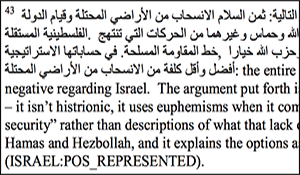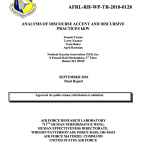Discourse Analysis of In- and Out-Group Arabic News

Analysis of Discourse Accent and Discursive Practices Indicators & Warnings Practices I&W.
Author | Editor: Toman, P., Kuznar, L., Baker, T. & Hartman, A. (NSI, Inc).
Because 1) discourse is not neutral, and 2) people differentiate between in-groups and out- groups, discourse almost always reflects an individual’s in-group and out-group assumptions. Boundary maintenance between groups that are “good” or “like us” (in-groups) and those that are “unlike us” or “bad” (out-groups) forms a significant – albeit often subconscious – part of discourse. This is true for all languages and societies, including both English- and Arabic- speaking.
This project was initiated at the request of behavior influence analysts at the National Air and Space Intelligence Center (NASIC). NASIC had found the distinction between “in-groups” and “out-groups” useful for their analyses. This effort was initiated to explore this phenomenon further, to assess how in-groups and out-groups are indexed and constructed in texts. Specifically, the goal was to develop a systematic methodology for identifying and interpreting in-group/out-group discursive practices in Arabic. The intent was to solidify an approach that could focus analysts’ attention on issues of in/out group dynamics, as well as be reproducible and trainable.
The research effort proceeded in two phases. Phase I was dedicated to covering the academic literature on discourse analysis and the initial construction of a codebook. The codebook contains a catalogue of linguistic devices used to express in/out group sentiments in Arabic. Phase II was focused on expanding that codebook and integrating insights from linguistically trained Arabic speakers and Arabic speakers with a more colloquial understanding of how in/out group sentiments are expressed; that is, to create a methodology that was natural and did not require formal training or expertise in critical discourse analysis. In addition, a proof-of-concept was conducted of an existing methodology for tracking relations between people and groups, called cognitive or integrative complexity analysis. Cognitive complexity analysis refers to a specific methodology developed in the field of political psychology that is used on the discourse of political elites. It does not provide sentiment analysis, but it does provide indicators of when one group is likely to act violently toward another group. Finally, a survey of alternative methods to consider for future work was completed.
Before developing a methodology/codebook, a literature search (Appendix A) was conducted encompassing social psychology, the history of discourse analysis and other social science literature related to narratives and discourse (e.g., political science related literature on cognitive complexity and integrative complexity). The literature search identified discursive mechanisms related to in-group/out-group. In-group alliance and out-group distancing are reflected linguistically through numerous discourse phenomena. As determined by the review of academic discourse analytic literature and analyzing Arabic newspaper discourse, the most significant techniques that establish in-groups and out-groups in third-person Arabic newspaper analytic prose include:
- Lexicalization (word choice)
- Quotations
- References
- Allusion
Monitoring linguistic phenomena, with attention to these four in particular, can help identify and track alliances and tensions between groups over time. Focusing on these in-group/out-group related discursive mechanisms, a case study was conducted with Arabic documents provided by NASIC to identify the ways in which these discursive mechanisms manifest in Arabic discourse. The result of this was a critical discourse analysis based Methodological Primer for in-group/out- group discourse in Arabic (Appendix C).
In order to validate the extensibility and robustness of this methodology, a subsequent study with more Arabic speakers and more Arabic documents was conducted. This second study resulted in a new methodology (Appendix F) which did not require any training in critical discourse analysis. In developing this second approach, there was the progression from the insights of a single academically trained analyst, to focus groups of academically trained analysts, to a larger body of colloquial readers. The resulting codebook incorporated the insights of both expert linguists and ordinary speakers through the application of grounded theory. From coding Arabic speakers’ analyses during the final phase of the project, a series of ten “factors” was identified along which Arabic speakers assess in/out group alignments in Arabic documents. These factors cue the reader or analyst to understand a particular group as a member of the author’s in-group or a member of the author’s out-group. One of the conclusions of this second study, among other quantitative findings, was that although analyst language level affects which of these factors are noted, there is no statistically significant difference between (self-rated) native speakers of Arabic and near-native speakers in identifying the in-group/out-group factors.
In addition, a proof-of –concept of the cognitive complexity/integrative complexity assessment method was explored. The notion is that this could provide another method to assist an analyst in interpreting discourse. Cognitive complexity measures a subject’s psychological complexity as represented by their public statements and writings, which can be used as an indicator and warning of impending hostilities. Integrative complexity measures the ability of an individual to see multiple perspectives of an issue or situation and integrate those viewpoints or perspectives. Higher integrative complexity has been correlated with cooperative behavior.
The critical event used for the proof of concept of integrative complexity assessment was the assassination of former Lebanese Prime Minister Rafic Hariri on February 14, 2005. In particular, the statements of Syrian President Bashar Al-Assad in the interval immediately before and after the Hariri assassination in 2005 were used to assess whether changes in integrative complexity, as suggested by the literature, could serve as an instructive analytical tool in the run up to serious international events. This is a particularly useful case study because of Al-Assad’s denial of Syria’s involvement in the assassination and the international community’s contradictory conclusion that there was some level of Syrian involvement (based upon the Mehlis investigation). Based upon this Al-Assad case study, National Security Innovations, Inc. (NSI) found a statistically significant (p-value=.01) difference between the period immediately prior to the assassination of Rafic Hariri (October 2004 thru January 2005) and both Al-Assad’s baseline (October 2003 thru May 2004) or the period following the assassination (February 2005 thru December 2005). This confirms the general research findings in the political psychology literature.
In summary, the following was accomplished:
- Literature search of discourse analysis with a view to applying it to identifying, understanding and interpreting in-group/out-group discourse
- Initial case study of critical discourse analysis methodology for identifying in-group/out- group discursive mechanisms in Arabic and development of primer
- Subsequent case study of Arabic in-group/out-group discourse which identified key rhetorical phenomena and intensifiers
- Development of a phased method for using analysts with different levels of training to produce codebooks
- Method made use of manually and automatically retrieved web documents
- Method progressed from a single academically trained analyst, to focus groups of academically trained analysts to a larger body of colloquial readers, enabling the construction of a code book that incorporated both expert linguistic and more common views
- Discovered 10 factors by which Arabic speakers assess in/out group alignments in Arabic news documents, and 13 factors by which Arabic speakers assess intensification of sentiment
- Proof –of-concept of integrative complexity, as developed by Suedfeld and Tetlock, demonstrated the potential to provide indicators and warnings of possible changes in threat posturing through the analysis of leader’s and political elites’ public statements; Bashar Al-Assad’s cognitive complexity shifted as predicted by the literature, with his cognitive complexity decreasing in the period prior to the assassination of Hariri and returning to baseline in the aftermath
- Application and adoption of grounded theory to coordinated analysis
- Exploration of the effect of analyst language skill and linguistic training on coding
Future work will likely employ the discourse methodology and the cognitive complexity methodology in tandem to provide independent streams of evidence concerning how groups are aligned with one another. In addition, some recommendations are made of other potential methods (e.g., narrative analysis, ethnographic approaches) that may be useful for tracking intergroup relations through their discourse

Comments